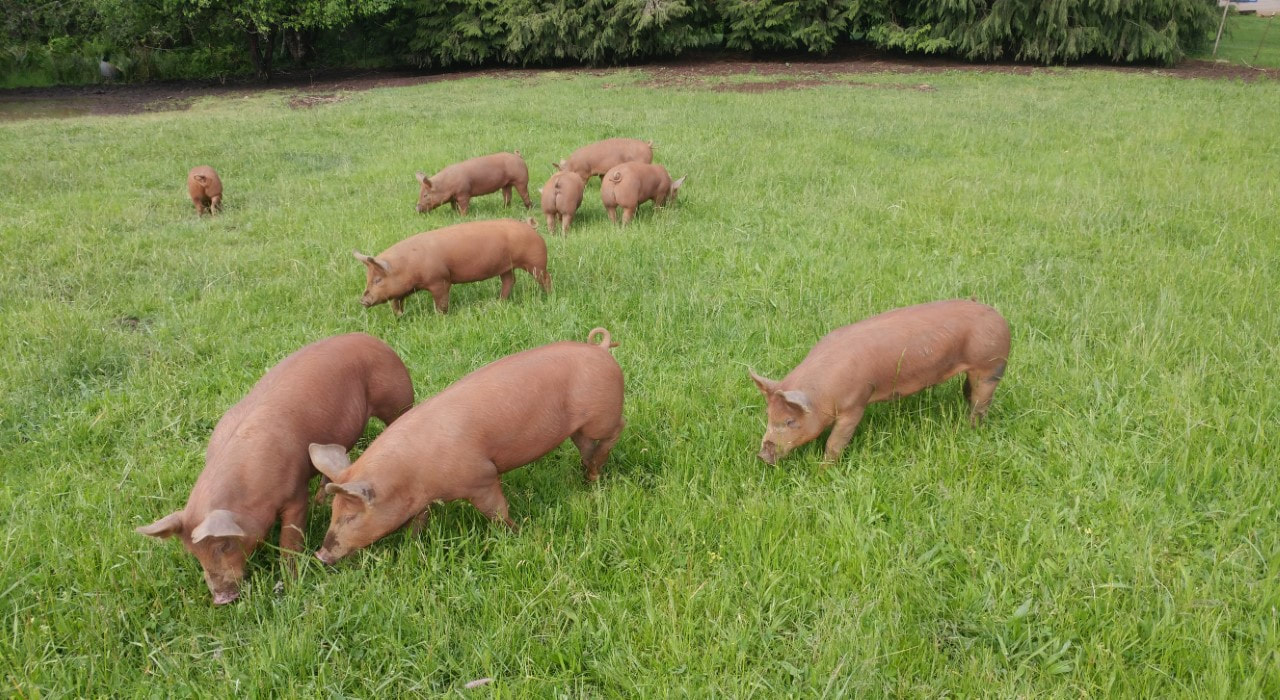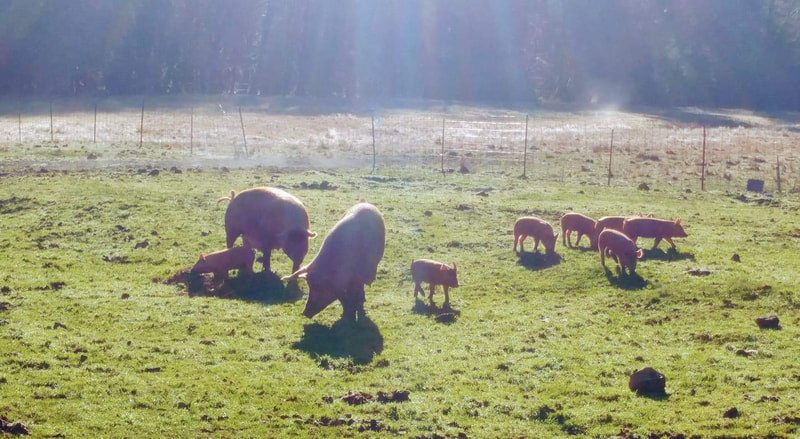History of the Tamworth hog from the American Livestock Conservancy- “The Tamworth originated in central England in the counties of Stafford, Warwick, Leicester, and Northhampton. Prior to 1815, dark red and grisly pigs were found largely in these Midland counties. In this region, there were dense forests of oak and beech trees where the pigs were kept to forage in the autumn and winter. The breed takes its name from the village of Tamworth in Staffordshire.
Long, lean, and athletic, the Tamworth is probably the most direct descendant of the native pig stock of northern Europe. There is historic documentation that some of the stock used to develop the breed may have had an Irish origin through an importation around 1812 by Sir Robert Peel (Prime Minister of the United Kingdom between 1834-1835 and 1841-1846) to his farm in Tamworth. Peel is reported to have crossed the Irish pigs with the local pigs of Tamworth at that time. The Tamworth breed was standardized during the early to mid-1800s, becoming uniform in type. The Tamworth was recognized as a breed by the Royal Agricultural Society in 1885 and fell under the authority of the National Pig Breeders’ Association of Great Britain.
Tamworth pigs were first imported to North America by Thomas Bennett of Rossville, Illinois in 1882. Many more Tamworths were imported into Canada after 1888. The American Tamworth Swine Record Association was founded in 1887 with their national headquarters in Ames, Iowa. In Canada the Tamworth was admitted to the Dominion Swine Breeders Association Herd Book in 1893.
The characteristics of the Tamworth reflect the breed’s centuries of selection for an outdoor life. Pigs of this breed were expected to find their own food, especially mast (or acorns) of oak and beech forests. Long heads and impressive snouts enable these pigs to be efficient foragers. Long, strong legs and sound feet give Tamworth pigs the ability to walk for considerable distances. Ginger red coats make the pigs adaptable to a variety of climates and protect them from sunburn. Tamworths have an active intelligence, and they are agreeable in disposition. Sows are prolific, able to produce and care for large litters. The piglets are vigorous and often have 100% survivability. Both sexes of this breed reach a mature weight of 500-600 lbs. “
Tamworth hogs are known as a bacon breed, traditionally having long bellies resulting in excellent lean bacon and fine grained pork. The breed has an excellent carcass yield of up to 70% due to their fine bones creating a more productive meat to bone ratio for finished meat products.
My Tamworth breeding stock are registered with the Tamworth Swine Association. The sows farrow in large stalls where the piglets will be warm, dry and safe during the first few days of life, and also where I can safely handle them, they are then turned out to have access to outdoors. I prefer to wean piglets at 7 weeks of age but it may vary between 6-8 weeks. I believe leaving the piglets on the sow for several weeks results in healthier, more robust pigs! Piglets are available mostly year round but are limited and a very few select piglets are available as registered breeding stock while the majority are sold for meat. Deposits are taken after piglets are born.
Pigs that stay here to be raised for pork live outdoors and graze on pasture. They are primarily fed a locally sourced pea and barley based ground grain or standard pellets, seasonal fruit and veggies, milk and they enjoy alfalfa and grass hay. I feed and breed for flavorful pork that can't be compared to the store bought "other white meat”.
Currently taking reservations for 2022 weaner pigs! Spring pigs sell quickly so contact me early to get on my list. Deposits are not taken until after piglets are born. 8 week old weaners to raise for meat are $150.
Registered breeding stock are $400 each between 8-12 weeks. Delivery is an option, contact us to learn more.
I have been able to farrow the first three litters of English sired Tamworth pigs in the US in November 2020, January 2021 and July 2021 and have them accepted by the Tamworth Swine Association for registration! The half English Tamworths will form about half of my breeding herd in 2022, the other half being full American registered Tamworths. My vision is traditional type, able to forage and farrow easily and efficiently, and produce the best pork possible for the breed. To fit the breed standard and closer resemble the American Tamworths of the past and the current English type. True heritage, not show or modern.
Long, lean, and athletic, the Tamworth is probably the most direct descendant of the native pig stock of northern Europe. There is historic documentation that some of the stock used to develop the breed may have had an Irish origin through an importation around 1812 by Sir Robert Peel (Prime Minister of the United Kingdom between 1834-1835 and 1841-1846) to his farm in Tamworth. Peel is reported to have crossed the Irish pigs with the local pigs of Tamworth at that time. The Tamworth breed was standardized during the early to mid-1800s, becoming uniform in type. The Tamworth was recognized as a breed by the Royal Agricultural Society in 1885 and fell under the authority of the National Pig Breeders’ Association of Great Britain.
Tamworth pigs were first imported to North America by Thomas Bennett of Rossville, Illinois in 1882. Many more Tamworths were imported into Canada after 1888. The American Tamworth Swine Record Association was founded in 1887 with their national headquarters in Ames, Iowa. In Canada the Tamworth was admitted to the Dominion Swine Breeders Association Herd Book in 1893.
The characteristics of the Tamworth reflect the breed’s centuries of selection for an outdoor life. Pigs of this breed were expected to find their own food, especially mast (or acorns) of oak and beech forests. Long heads and impressive snouts enable these pigs to be efficient foragers. Long, strong legs and sound feet give Tamworth pigs the ability to walk for considerable distances. Ginger red coats make the pigs adaptable to a variety of climates and protect them from sunburn. Tamworths have an active intelligence, and they are agreeable in disposition. Sows are prolific, able to produce and care for large litters. The piglets are vigorous and often have 100% survivability. Both sexes of this breed reach a mature weight of 500-600 lbs. “
Tamworth hogs are known as a bacon breed, traditionally having long bellies resulting in excellent lean bacon and fine grained pork. The breed has an excellent carcass yield of up to 70% due to their fine bones creating a more productive meat to bone ratio for finished meat products.
My Tamworth breeding stock are registered with the Tamworth Swine Association. The sows farrow in large stalls where the piglets will be warm, dry and safe during the first few days of life, and also where I can safely handle them, they are then turned out to have access to outdoors. I prefer to wean piglets at 7 weeks of age but it may vary between 6-8 weeks. I believe leaving the piglets on the sow for several weeks results in healthier, more robust pigs! Piglets are available mostly year round but are limited and a very few select piglets are available as registered breeding stock while the majority are sold for meat. Deposits are taken after piglets are born.
Pigs that stay here to be raised for pork live outdoors and graze on pasture. They are primarily fed a locally sourced pea and barley based ground grain or standard pellets, seasonal fruit and veggies, milk and they enjoy alfalfa and grass hay. I feed and breed for flavorful pork that can't be compared to the store bought "other white meat”.
Currently taking reservations for 2022 weaner pigs! Spring pigs sell quickly so contact me early to get on my list. Deposits are not taken until after piglets are born. 8 week old weaners to raise for meat are $150.
Registered breeding stock are $400 each between 8-12 weeks. Delivery is an option, contact us to learn more.
I have been able to farrow the first three litters of English sired Tamworth pigs in the US in November 2020, January 2021 and July 2021 and have them accepted by the Tamworth Swine Association for registration! The half English Tamworths will form about half of my breeding herd in 2022, the other half being full American registered Tamworths. My vision is traditional type, able to forage and farrow easily and efficiently, and produce the best pork possible for the breed. To fit the breed standard and closer resemble the American Tamworths of the past and the current English type. True heritage, not show or modern.















